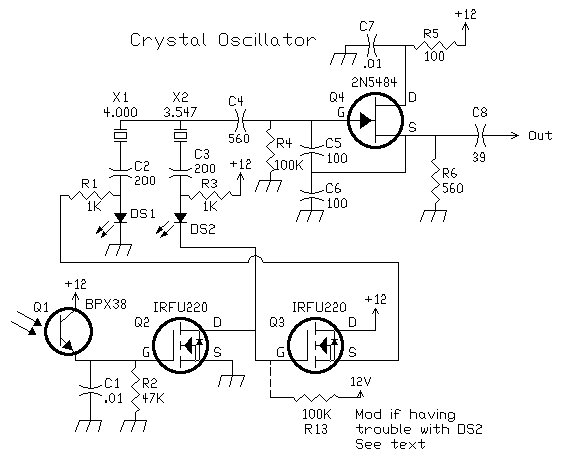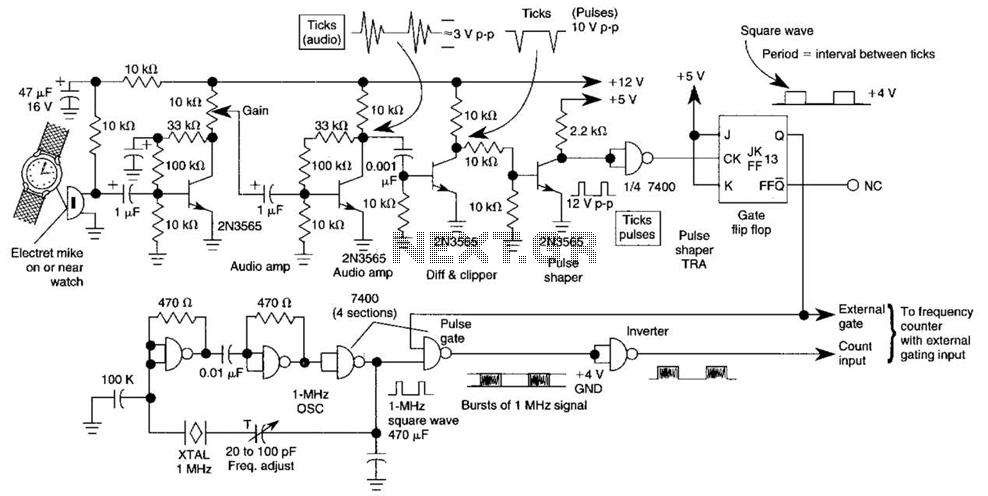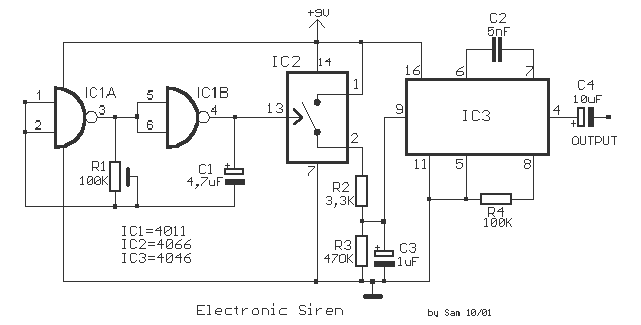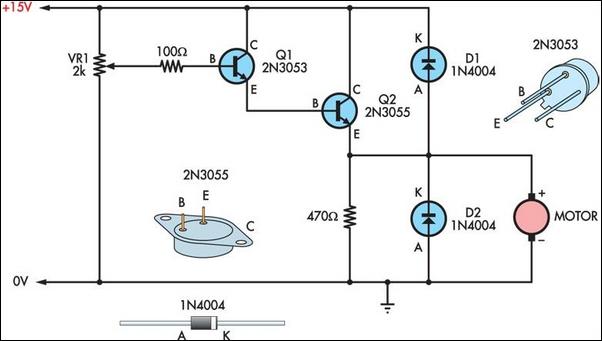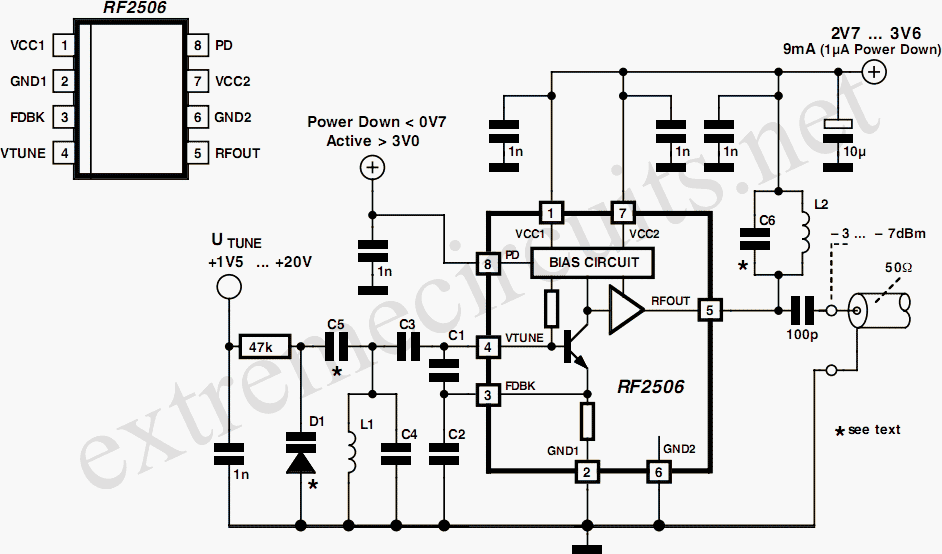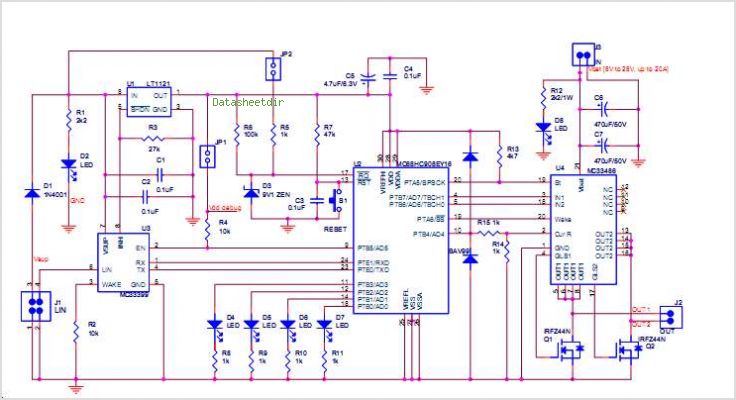
Street light control circuit
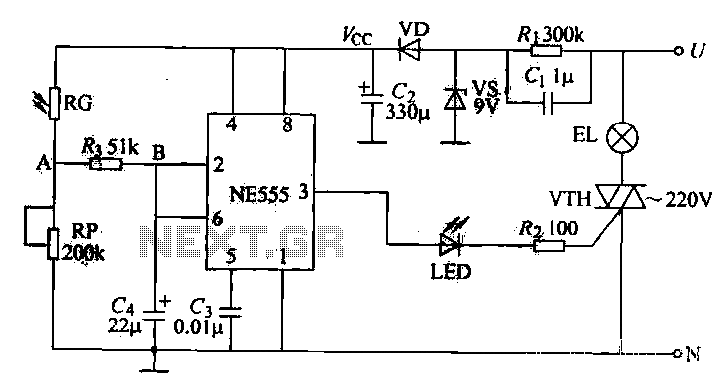
Streetwear trench pipe installation commonly utilizes concealed wiring methods. The control section is installed at the front door or in a centralized control room, managed by a duty electrician. The street factory area is illustrated in a figure. This installation not only facilitates convenient transportation but also enhances leisure activities for people walking, playing, or exercising along the road. The streetlight control circuit is characterized by its stability and reliability, ensuring it does not cause glare, accidental erroneous operations, or flashes. The streetlight control circuit comprises a light control flip-flop circuit, a switching circuit, and a power supply circuit, as shown in Figure 16-45b. The light control flip-flop circuit consists of a photosensitive resistor (RG), a potentiometer (RP), a capacitor (C3), resistors (R3), and an integrated circuit (NE555). The switching circuit is made up of a thyristor (VTH), a resistor (R2), and a light-emitting diode (LED). The power circuit includes a step-down capacitor (Ci), a resistor (R), a voltage regulator diode (VS), a rectifier diode (VD), and a filter capacitor (C2). The AC 220V voltage is stepped down by Ci, regulated by VS, rectified, and filtered through VD to produce an 8.5V DC voltage supply for the NE555. During the day, the photosensitive resistor RG is influenced by light, causing it to enter a low-resistance state. The voltage at pin 2 of the NE555 exceeds 2/3 of the supply voltage, resulting in a low output from the NE555, which keeps the LED off, and the thyristor VTH remains in the off state, preventing the EL lamp from illuminating. As night falls and light intensity decreases, the resistance of the photosensitive resistor RG increases, leading to a drop in voltage at pin 2 of the NE555. When this voltage falls below 1/3 of the supply voltage, the NE555's output switches from low to high, turning on the LED and triggering the thyristor VTH to conduct, thereby illuminating the EL lamp.
The streetlight control circuit provides a robust solution for automated street lighting management, ensuring efficient energy usage and enhanced safety for pedestrians. Its design incorporates a photosensitive resistor to detect ambient light levels, allowing for automatic switching of streetlights based on natural light conditions. This feature is particularly beneficial in urban environments where lighting needs can vary significantly throughout the day and night.
The integration of the NE555 timer circuit serves as the heart of the control mechanism, enabling precise timing and control functions. The use of a thyristor in the switching circuit allows for effective control of high-power loads, such as street lamps, while the LED provides visual feedback for the operational status of the circuit. The filtering and rectification stages ensure that the power supply to the NE555 is stable and sufficient for reliable operation.
Overall, this streetlight control circuit exemplifies an effective application of electronic components to achieve a practical solution for urban lighting challenges, promoting both efficiency and safety in public spaces.Street wear trench pipe installation commonly used Concealed wiring methods. The control section is installed in the front door or in the centralized control room duty electrician. Street factory area is shown in a FIG. In addition to its convenient transportation, but also the people along the road of leisure, walking, play, exercise areas. Works street light control circuit: street light control is characterized by stable and reliable, and will not cause glare accidental erroneous operation or flashes.
The street light control circuit consists of light control flip-flop circuit, a switching circuit and power supply circuit, as shown in Figure 16-45b. Street light control circuit, the light control flip-flop circuit by the photosensitive resistor RG. Potentiometer RP, capacitor C3,0, resistors R3 and base integrated circuit NE555 composition; switching circuit consists of thyristor VTH, the resistor R2 and the light emitting diode LED composition; power circuit consists of step-down capacitor Ci, resistor R ,, steady pressure diode vS, composed rectifier diode VD and filter capacitor G.
AC 220V step-down voltage by Cl, vs regulator, VD C2 rectified and filtered to produce 8. SV (V0) DC voltage supply NE555. During the day, photoresistor RG affected by light exposure to the low resistance state, feet and feet higher than the potential of NE555 2V.T / 3, NE555 the pin output low, LED does not light-emitting diode, thyristor VTH is off state, EL lamp does not light. When night falls, the light intensity gradually weakened, photosensitive resistor RG resistance increases.
pin voltage NE555 feet and have begun to decline, when the voltage drops below the feet V "/ 3 ±, NE555 internal flip . feet from low to high, the LED is turned on hair light. VTH triggered by conduction, the EL lamp is lit.
The streetlight control circuit provides a robust solution for automated street lighting management, ensuring efficient energy usage and enhanced safety for pedestrians. Its design incorporates a photosensitive resistor to detect ambient light levels, allowing for automatic switching of streetlights based on natural light conditions. This feature is particularly beneficial in urban environments where lighting needs can vary significantly throughout the day and night.
The integration of the NE555 timer circuit serves as the heart of the control mechanism, enabling precise timing and control functions. The use of a thyristor in the switching circuit allows for effective control of high-power loads, such as street lamps, while the LED provides visual feedback for the operational status of the circuit. The filtering and rectification stages ensure that the power supply to the NE555 is stable and sufficient for reliable operation.
Overall, this streetlight control circuit exemplifies an effective application of electronic components to achieve a practical solution for urban lighting challenges, promoting both efficiency and safety in public spaces.Street wear trench pipe installation commonly used Concealed wiring methods. The control section is installed in the front door or in the centralized control room duty electrician. Street factory area is shown in a FIG. In addition to its convenient transportation, but also the people along the road of leisure, walking, play, exercise areas. Works street light control circuit: street light control is characterized by stable and reliable, and will not cause glare accidental erroneous operation or flashes.
The street light control circuit consists of light control flip-flop circuit, a switching circuit and power supply circuit, as shown in Figure 16-45b. Street light control circuit, the light control flip-flop circuit by the photosensitive resistor RG. Potentiometer RP, capacitor C3,0, resistors R3 and base integrated circuit NE555 composition; switching circuit consists of thyristor VTH, the resistor R2 and the light emitting diode LED composition; power circuit consists of step-down capacitor Ci, resistor R ,, steady pressure diode vS, composed rectifier diode VD and filter capacitor G.
AC 220V step-down voltage by Cl, vs regulator, VD C2 rectified and filtered to produce 8. SV (V0) DC voltage supply NE555. During the day, photoresistor RG affected by light exposure to the low resistance state, feet and feet higher than the potential of NE555 2V.T / 3, NE555 the pin output low, LED does not light-emitting diode, thyristor VTH is off state, EL lamp does not light. When night falls, the light intensity gradually weakened, photosensitive resistor RG resistance increases.
pin voltage NE555 feet and have begun to decline, when the voltage drops below the feet V "/ 3 ±, NE555 internal flip . feet from low to high, the LED is turned on hair light. VTH triggered by conduction, the EL lamp is lit.
